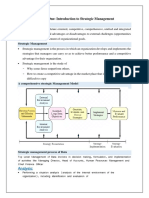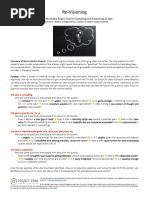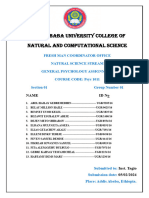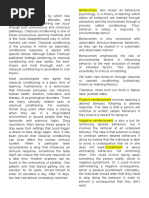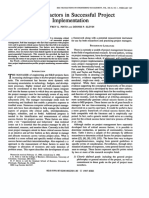0 ratings0% found this document useful (0 votes)
75 views4 P's Exercise
4 P's Exercise
Uploaded by
Titania Shinri-GakuThis document describes an exercise called the "4 P's Exercise" that helps connect a project to intended outcomes and impacted employee groups. The exercise involves creating four columns - Project, Purpose, Particulars, and People. For each project, the columns are filled out to identify the project name, goals, specific changes, and impacted individuals. Walking through this process helps audiences understand how the project impacts the organization and why change management is important for success. An example is provided to illustrate how the exercise works.
Copyright:
© All Rights Reserved
Available Formats
Download as PDF, TXT or read online from Scribd
4 P's Exercise
4 P's Exercise
Uploaded by
Titania Shinri-Gaku0 ratings0% found this document useful (0 votes)
75 views5 pagesThis document describes an exercise called the "4 P's Exercise" that helps connect a project to intended outcomes and impacted employee groups. The exercise involves creating four columns - Project, Purpose, Particulars, and People. For each project, the columns are filled out to identify the project name, goals, specific changes, and impacted individuals. Walking through this process helps audiences understand how the project impacts the organization and why change management is important for success. An example is provided to illustrate how the exercise works.
Original Description:
Prosci
Copyright
© © All Rights Reserved
Available Formats
PDF, TXT or read online from Scribd
Share this document
Did you find this document useful?
Is this content inappropriate?
This document describes an exercise called the "4 P's Exercise" that helps connect a project to intended outcomes and impacted employee groups. The exercise involves creating four columns - Project, Purpose, Particulars, and People. For each project, the columns are filled out to identify the project name, goals, specific changes, and impacted individuals. Walking through this process helps audiences understand how the project impacts the organization and why change management is important for success. An example is provided to illustrate how the exercise works.
Copyright:
© All Rights Reserved
Available Formats
Download as PDF, TXT or read online from Scribd
Download as pdf or txt
0 ratings0% found this document useful (0 votes)
75 views5 pages4 P's Exercise
4 P's Exercise
Uploaded by
Titania Shinri-GakuThis document describes an exercise called the "4 P's Exercise" that helps connect a project to intended outcomes and impacted employee groups. The exercise involves creating four columns - Project, Purpose, Particulars, and People. For each project, the columns are filled out to identify the project name, goals, specific changes, and impacted individuals. Walking through this process helps audiences understand how the project impacts the organization and why change management is important for success. An example is provided to illustrate how the exercise works.
Copyright:
© All Rights Reserved
Available Formats
Download as PDF, TXT or read online from Scribd
Download as pdf or txt
You are on page 1of 5
Connecting Change to Business Results: The 4 P’S Exercise
The goal of this exercise is to show the connection between the project, the intended outcomes and the employee groups who will be
impacted by the effort by slowly and purposefully identifying four key elements of the change. The most important thing you can do is
help your audience make this connection themselves.
While it may seem like common sense, the impact for the audience can be significant. Walking project leaders, project teams, senior
managers and change sponsors through the process below helps create the “ah ha” moment that cannot be achieved by simply telling
someone about the importance of change management.
Step 1 - Create Four Columns
The exercise is a simple build. Start by creating four columns on a blank sheet of paper. If you are facilitating this as group discussion,
you may use a white board or flip chart. You can also have each person create their own columns on a sheet of paper in front of them.
Step 2 - Identify the Project
Begin by having your audience label the first column Project Name. Have your audience pick a project they are familiar with and that is
important to them and write the name in the first column. What is the project we are thinking about? Examples include: Global ERP,
Supply Chain Optimization, eBenefits 2.5, Create PMO, etc.
Step 3 - Identify the Purpose
Next, label column two Purpose. Here, have your audience write down the specific goals or outcomes the project is trying to achieve.
Why are we doing this project in the first place? What is the benefit to the organization? Examples include: Reduce cost, increase revenue,
improve margin, introduce new product, reallocate inventory, streamline business processes, merge parts of the organization, implement
unified data source for entire organization or implement common business practices.
© Prosci, Inc. All rights reserved. | 1
Step 4 - Identify the Particulars
The third column is labeled Particulars. In this column, write down exactly what will be changing in the organization - the nuts and bolts
of the change. Document the specific impacts to business processes, systems, tools, job roles or organizational structures. Really work to
describe what will be different in the future than it is today.
Step 5 - Identify the People
Have your audience label the final column People. Here, identify who in the organization will have to change how they work. Whose
day-to-day activities will be impacted by this project? Who will be doing things differently after the project is implemented? And, the
answer “everyone” is not good enough - you need to be specific!
Step 6 - Creating the context
The four columns in the Project-Purpose-Particulars-People exercise, and more importantly the process of labeling and filling in each
column, helps create a context for the project. It ties the project to why it is happening, to what specifically will be changing, and most
importantly to who will be impacted by the change.
Step 7 - Making the connection
The connection between the columns is the key. When you use the exercise with a project team, you are forcing them to think about the
individual impacts of their project or initiative. If we do not manage the people side of change, it really doesn’t matter what specific changes
are architected (in the Particulars column) because they won’t be realized. And if people don’t change how they do their jobs, we ultimately
won’t achieve the benefits we were looking for from the project (in the Purpose column). Return on investment will not be realized. The
project will not deliver results.
The Final Step – Positioning change management
The outcome we are looking for might sound something like: “Thank you for helping me better understand the initiative and the impacted
groups for this effort. Now that we have an inventory of who has to adopt the change for the project to succeed, I can begin creating change
management plans and activities to actively engage these groups.”
© Prosci, Inc. All rights reserved. | 2
The 4 P’s Exercise: Example
Project Purpose Particular People
(What is the Project?) (Why we are changing?) (What are we changing?) (Who will be changing?)
• Department Chair • To create a structure • Reporting Structure • Department Chairs
Role Redesign that supports holistic • Evaluations • Program Chairs
program management • Program Accountability • Program Directors
• Empowers and trusts our • Compensation • Full Time Faculty
program/department chairs • Assignments • Academic Deans
to run areas effectively • Succession Planning • Institutional Admin
© Prosci, Inc. All rights reserved. | 3
The 4 P’s Exercise
Project Purpose Particular People
(What is the Project?) (Why we are changing?) (What are we changing?) (Who will be changing?)
© Prosci, Inc. All rights reserved. | 4
Change Management Certification Program
Gain the tools to successfully apply change management to a project
and communicate the value of change management to others in your
organization at the Prosci Change Management Certification Program
Contact Prosci to learn more.
FOLLOW US:
© Prosci, Inc. All rights reserved. | 5
You might also like
- The Prosci ADKAR Model EbookDocument19 pagesThe Prosci ADKAR Model EbookAnonymous Cj2w3omk100% (8)
- Ikigai Worksheet PDFDocument3 pagesIkigai Worksheet PDFmarcoarosa89% (9)
- OGL 320: Foundations of Project Management Module 6 Reflection WorksheetDocument11 pagesOGL 320: Foundations of Project Management Module 6 Reflection Worksheetapi-479140643No ratings yet
- Change and Project Management Toolkit - Overview and ApproachDocument48 pagesChange and Project Management Toolkit - Overview and ApproachSARA LOGAB100% (2)
- The Prosci ADKAR Model Overview EbookDocument19 pagesThe Prosci ADKAR Model Overview EbookErvin PregNo ratings yet
- Final Reflection Spectrum Sunglass PDFDocument11 pagesFinal Reflection Spectrum Sunglass PDFRio Sam100% (1)
- Building A Pmo From The Ground Up: Karl Knapp, Mba Amerus Group / Indianapolis LifeDocument52 pagesBuilding A Pmo From The Ground Up: Karl Knapp, Mba Amerus Group / Indianapolis LifeKamran QamarNo ratings yet
- A Cultural Transformation ProposalDocument13 pagesA Cultural Transformation Proposalsnehhrd2No ratings yet
- August RushDocument4 pagesAugust RushClaudette ColinaresNo ratings yet
- PROSCI Aug Cop Webinar Revisit Your Toolbox Slideshare-180821041406Document18 pagesPROSCI Aug Cop Webinar Revisit Your Toolbox Slideshare-180821041406Spil_vv_IJmuidenNo ratings yet
- Welcome To Becker's On Demand CPE Course!Document51 pagesWelcome To Becker's On Demand CPE Course!Muhammad WaseemNo ratings yet
- Pre Work For PCTDocument10 pagesPre Work For PCTAashutosh YadavNo ratings yet
- Organizational Capability Assessment - ResultsDocument6 pagesOrganizational Capability Assessment - ResultsgfraoterNo ratings yet
- 04 Digital Change - Personalizing the Change Experience_Individual ImpactDocument54 pages04 Digital Change - Personalizing the Change Experience_Individual Impactmatias.coralesNo ratings yet
- Project Management PDFDocument36 pagesProject Management PDFHồ ThắngNo ratings yet
- Best Practices - The Nine Elements To SuccessDocument11 pagesBest Practices - The Nine Elements To SuccessDieudonné AllaramadjiNo ratings yet
- Project Management IntroductionDocument9 pagesProject Management Introductionkim cheNo ratings yet
- Capturing, Analyzing, and Using Project Leasson LearnedDocument26 pagesCapturing, Analyzing, and Using Project Leasson LearnedDomenico FaraiNo ratings yet
- Five R For LSS Project Execution Success - Materi Webinar 2Document18 pagesFive R For LSS Project Execution Success - Materi Webinar 2AnggerNo ratings yet
- Fundamentals of Project Management: Unit 1Document39 pagesFundamentals of Project Management: Unit 1Jyoti Arvind PathakNo ratings yet
- Chapter 1Document64 pagesChapter 1mitraNo ratings yet
- Change Management Learning CenterDocument12 pagesChange Management Learning CenterPratibha GhugtyalNo ratings yet
- Change ManagementDocument9 pagesChange ManagementGerald VassalloNo ratings yet
- Change ManagementDocument26 pagesChange ManagementAshish PalNo ratings yet
- ProjectDocument19 pagesProjectrishabhdubey4545No ratings yet
- Student Slides - LO1 Part BDocument53 pagesStudent Slides - LO1 Part BHiền NguyễnNo ratings yet
- Why Do You Say That Project Management Is The Best Method of Implementing ChangeDocument10 pagesWhy Do You Say That Project Management Is The Best Method of Implementing ChangeFaisal HameedNo ratings yet
- PM-Lecture-9Document29 pagesPM-Lecture-9saumya shahNo ratings yet
- Software Engineering Unit 1 - Part 2Document27 pagesSoftware Engineering Unit 1 - Part 2Shirisha VNo ratings yet
- How do you measure and report the scope performance and progress of your project_Document6 pagesHow do you measure and report the scope performance and progress of your project_sharoon2014No ratings yet
- Prosci Onsite Training Change MGMTDocument8 pagesProsci Onsite Training Change MGMTHenrique Narciso100% (1)
- The Change Leaders Roadmap - How To Navigate The Complexities of Your Organizations TransformationDocument10 pagesThe Change Leaders Roadmap - How To Navigate The Complexities of Your Organizations TransformationAkhilesh ChaturvediNo ratings yet
- LMS-Week-1--Lecture-13092024-113119pmDocument39 pagesLMS-Week-1--Lecture-13092024-113119pmmirzawaqas906No ratings yet
- Capstone Anwar Shikarwar - 214100122Document40 pagesCapstone Anwar Shikarwar - 214100122shikarwar.anwarNo ratings yet
- DOES Forum LeadingChange 112016Document58 pagesDOES Forum LeadingChange 112016chemikas8389No ratings yet
- Project Management Basics: A Hands-On Workshop For Today's "Instant" Project ManagersDocument32 pagesProject Management Basics: A Hands-On Workshop For Today's "Instant" Project ManagersSachin Kumar BassiNo ratings yet
- Handbook 2023 2.enactus ProjectsDocument18 pagesHandbook 2023 2.enactus ProjectssugainfiresmemoreNo ratings yet
- Sample Change Management Job DescriptionDocument3 pagesSample Change Management Job DescriptionLoai HelaifiNo ratings yet
- Change Management at The Project LevelDocument5 pagesChange Management at The Project LevelRey MattheusNo ratings yet
- LPS StepsDocument20 pagesLPS StepsLaruzAmalizSeguraGuzmánNo ratings yet
- Organization Change and Developement: 'Muddling Through" To Making MillionsDocument8 pagesOrganization Change and Developement: 'Muddling Through" To Making MillionsNidhi SinghNo ratings yet
- Step 1.1 Define Project/Programme Team Composition and OperationsDocument7 pagesStep 1.1 Define Project/Programme Team Composition and Operationsjoli504No ratings yet
- Step 1.1 Define Project/Programme Team Composition and OperationsDocument15 pagesStep 1.1 Define Project/Programme Team Composition and OperationsSan PedroNo ratings yet
- Leavitts Diamond - An Integrated Approach To ChangeDocument4 pagesLeavitts Diamond - An Integrated Approach To ChangeRosyNo ratings yet
- The Prosci ADKAR Overview Ebook PDFDocument18 pagesThe Prosci ADKAR Overview Ebook PDFIsrael Neri MoralesNo ratings yet
- Project ManagementDocument48 pagesProject ManagementYusuf ManuelNo ratings yet
- Chapter One Context of StratPrMDocument16 pagesChapter One Context of StratPrMBethlehem BirukNo ratings yet
- My Change Management Plan - WorkbookDocument13 pagesMy Change Management Plan - WorkbookluckystarNo ratings yet
- 2.what Is Project Management Definitions TermsDocument9 pages2.what Is Project Management Definitions TermsMusat MariusNo ratings yet
- Mastering The Case InterviewDocument42 pagesMastering The Case InterviewGoldy BhowmikNo ratings yet
- Project Closure Chapter OutlineDocument10 pagesProject Closure Chapter OutlineBasit KhanNo ratings yet
- SM Chapter One PDFDocument4 pagesSM Chapter One PDFRiduan Ullah KhanNo ratings yet
- 05.agile Project ManagementDocument58 pages05.agile Project Managementkhalid elbashierNo ratings yet
- Case Study OB2Document1 pageCase Study OB2Ambika PhalkeNo ratings yet
- Bischoff 2010 KnowledgeMgmtDocument3 pagesBischoff 2010 KnowledgeMgmtLayne Granados MogollonNo ratings yet
- LBC Booklet HRescheckDocument12 pagesLBC Booklet HRescheckRana ShahinNo ratings yet
- Term Paper of Project Management.Document38 pagesTerm Paper of Project Management.anuajn60% (10)
- Re VisioningDocument1 pageRe VisioningDom HussNo ratings yet
- Lean Change Overview For Org Change LeanKitDocument36 pagesLean Change Overview For Org Change LeanKitHernán MuñozNo ratings yet
- PMI Agile Community of PracticeDocument11 pagesPMI Agile Community of PracticeJosephConradNo ratings yet
- Christmas Tree GiftsDocument1 pageChristmas Tree GiftsTitania Shinri-GakuNo ratings yet
- Christmas Tree Gold 1Document1 pageChristmas Tree Gold 1Titania Shinri-GakuNo ratings yet
- HF Sticker 2Document1 pageHF Sticker 2Titania Shinri-GakuNo ratings yet
- Values in Action Inventory of StrengthDocument13 pagesValues in Action Inventory of StrengthTitania Shinri-GakuNo ratings yet
- The Dangers of Television: Harriet B. FidlerDocument3 pagesThe Dangers of Television: Harriet B. FidlerFerdinandus SipangkarNo ratings yet
- Psychology Group 1 Final AssignmentDocument8 pagesPsychology Group 1 Final Assignmentlemigobena12No ratings yet
- New Curriculum Formative Assessment NCDCDocument26 pagesNew Curriculum Formative Assessment NCDCRobert Kityo ProNo ratings yet
- Classical ConditioningDocument9 pagesClassical ConditioningFredie Boy SorromeroNo ratings yet
- Assignment 2 - Second Language Acquisition - Deadline 23rd SeptemberDocument6 pagesAssignment 2 - Second Language Acquisition - Deadline 23rd SeptemberMc ReshNo ratings yet
- Listening - Speaking-Day 1 2Document6 pagesListening - Speaking-Day 1 2Vy LêNo ratings yet
- Physical Development of Primary Schoolers (Middle Childhood)Document5 pagesPhysical Development of Primary Schoolers (Middle Childhood)Ginaly PicoNo ratings yet
- Gidaa Alamry: AbstractDocument15 pagesGidaa Alamry: AbstractJann Ernest R. FesalbonNo ratings yet
- Miss Brill - Themes & AnalysisDocument3 pagesMiss Brill - Themes & AnalysisMaría Paz MonteroNo ratings yet
- General Psychology: The Puzzle Box ExperimentDocument5 pagesGeneral Psychology: The Puzzle Box ExperimentMijingsree BoroNo ratings yet
- Q1 Social, Political and Cultural ChangeDocument10 pagesQ1 Social, Political and Cultural Changeapril rancesNo ratings yet
- Ahtisham HRM PaperDocument7 pagesAhtisham HRM PaperAhtisham NadeemNo ratings yet
- Psychosocial Theories 1Document42 pagesPsychosocial Theories 1AndreNo ratings yet
- Matos 2021Document22 pagesMatos 2021Windy NathasyaNo ratings yet
- Mr. Rogerss Simple Set of Rules For Talking To Kids - The AtlanticDocument10 pagesMr. Rogerss Simple Set of Rules For Talking To Kids - The Atlantic전유진No ratings yet
- Critical Factors in Successful Project Implementation: Abstract-This Paper Describes A Process Used To Determine CriticalDocument6 pagesCritical Factors in Successful Project Implementation: Abstract-This Paper Describes A Process Used To Determine CriticalAastha ShahNo ratings yet
- Uts Physical SelfDocument25 pagesUts Physical SelfJasmin AriateNo ratings yet
- Health and Physical Assessment in Nursing 3rd Edition DAmico Solutions Manual DownloadDocument7 pagesHealth and Physical Assessment in Nursing 3rd Edition DAmico Solutions Manual DownloadAdam West100% (24)
- The Impact of Personality andDocument15 pagesThe Impact of Personality andAISHWARYA SHENOY K P 2127635No ratings yet
- Parents ConsentDocument2 pagesParents ConsentMICHAEL RIVERONo ratings yet
- Attribution Theory - NewDocument6 pagesAttribution Theory - NewShraddha ShresthaNo ratings yet
- Consultative Selling Skills Author Harrison ConsultingDocument10 pagesConsultative Selling Skills Author Harrison Consultingvincentkumar772No ratings yet
- SAGAR MBA (Marketing HR) FRESHER ProfileDocument4 pagesSAGAR MBA (Marketing HR) FRESHER ProfileRoop KumarNo ratings yet
- My Failures in Dealing With Human Resource Management IssuesDocument5 pagesMy Failures in Dealing With Human Resource Management Issuesthegreatwriters8No ratings yet
- Behavior PlanDocument4 pagesBehavior Planapi-362823288No ratings yet
- Arts in The Modern World: Contemporary ArtDocument26 pagesArts in The Modern World: Contemporary ArtAshlyn MaeNo ratings yet
- AP Research Methods HandoutDocument3 pagesAP Research Methods Handouttesfayeyohannes537No ratings yet
- Adeeko YetundeDocument2 pagesAdeeko YetundeAdeeko YetundeNo ratings yet




















































